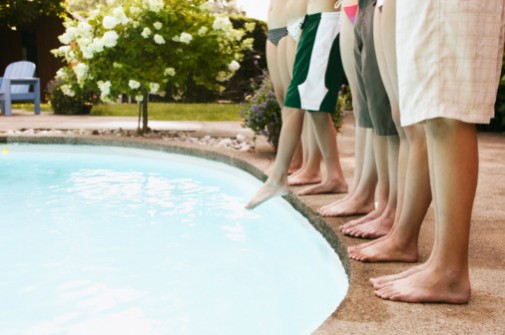Comment:
There is an alternative! Use for disinfecting swimming pool water no chlorine, but a Twin Oxide-0, 3% solution. The active ingredient of this solution is chlorine dioxide. This chlorine dioxide does not react with urea. This ensures that no toxic organochlorine compounds. It is understood, however, that you are aware of hygienic bathing. Urine does not belong in the pool water.
Kommentar:
Es gibt eine Alternative! Sie verwenden zur Desinfektion des Schwimmbadwassers kein Chlor, sondern eine TwinOxide-0,3%-Lösung. Der Wirkstoff dieser Lösung ist Chlordioxid. Dieses Chlordioxid reagiert nicht mit dem Harnstoff. Es entstehen damit keine toxischen chlororganischen Verbindungen. Es ist allerdings selbstverständlich, dass Sie hygienebewusst baden . Urin gehört nicht in das Schwimmbadwasser.
Poisoning by urine in a swimming pool?
http://derhonigmannsagt.wordpress.com/2014/04/04/harnsaure-als-ursprung-von-giftstoffen-in-chloriertem-wasser/
There is an alternative! Use for disinfecting swimming pool water no chlorine, but a Twin Oxide-0, 3% solution. The active ingredient of this solution is chlorine dioxide. This chlorine dioxide does not react with urea. This ensures that no toxic organochlorine compounds. It is understood, however, that you are aware of hygienic bathing. Urine does not belong in the pool water.
Kommentar:
Es gibt eine Alternative! Sie verwenden zur Desinfektion des Schwimmbadwassers kein Chlor, sondern eine TwinOxide-0,3%-Lösung. Der Wirkstoff dieser Lösung ist Chlordioxid. Dieses Chlordioxid reagiert nicht mit dem Harnstoff. Es entstehen damit keine toxischen chlororganischen Verbindungen. Es ist allerdings selbstverständlich, dass Sie hygienebewusst baden . Urin gehört nicht in das Schwimmbadwasser.
Poisoning by urine in a swimming pool?
Study shows
uric acid as the source of toxins in chlorinated water
Easy to make
fast to the pool: urinating in the pool is obviously prevalent not only in the
children's pool. A study of U.S. and Chinese scientists has now shown that this
is not only unsanitary, but downright toxic: uric acid in the urine serves as a
precursor for toxic chlorine compounds, the researchers write in the journal
"Environmental Science & Technology".
swimmingpool1g
Chlorine in
the water prevents microorganisms very effective because to multiply. In
swimming pools the pathogen keeps and ensures the clean water. As by-products,
however, it can also arise toxic chlorine compounds such as trichloramine
(NCl3) and cyanogen chloride (CNCl). A human contribution is obviously crucial:
Researchers led by Ernest R. Blatchley have found at Purdue University in the
U.S. that urine in chlorinated water is an important precursor for these
poisons.
The
scientists analyzed water samples from chlorinated swimming pool and
chlorinated solutions of uric acid and "body fluid analogous
mixtures", ie artificial urine samples. They have clearly found a strongly
increased content of NCl3 and CNCl. It was already known that these volatile
substances can form when chlorine in the swimming pool with sweat or urine. The
new results now demonstrate beyond doubt that the uric acid in the urine
"an efficient starting material for the formation of CNCl and NCl3"
as says Jing Li of the China Agricultural University.
More
hygienic, less toxic
According
to the study in the urine of swimmers Up to 90 percent of the uric acid found
escaped into the water. "It is a common misconception among swimmers that
urinating into the swimming pool as acceptable behavior," says Blatchley.
Despite widespread warnings and instructions and notes this is also and
especially common among competitive swimmers. The study results show that
hygienic behavior would significantly improve water quality. Blatchley
therefore calls for more awareness and consideration among pool visitors.
The
resulting compounds of chlorine and nitrogen are volatile and can be easily
inhaled. They damage primarily affects the lungs, but other organs. In
addition, they are considered carcinogenic. CNCl is also a known neurotoxin.
From both CNCl and NCl3 poisoning cases are already known: improper use of
chlorine-containing disinfectants and cleaning agents can easily accidents
happen. Also in swimming pools these toxins have led, according to the Centers
for Disease Control and Prevention have symptoms of poisoning.
http://derhonigmannsagt.wordpress.com/2014/04/04/harnsaure-als-ursprung-von-giftstoffen-in-chloriertem-wasser/
Harnsäure als Ursprung von Giftstoffen in chloriertem Wasser
4. April 2014 von beim Honigmann zu lesen


 Email
Email